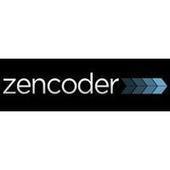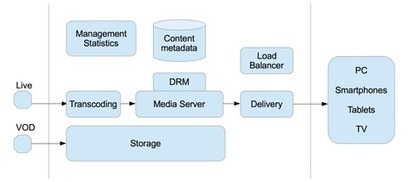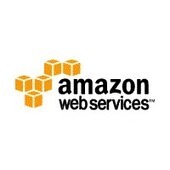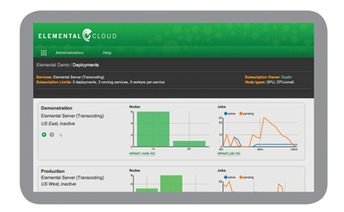 Your new post is loading...
 Your new post is loading...
Called ‘Ripcode Transcoder’, after the company Ripcode, which was acquired by RGB Networks in 2010 and which originally developed TransAct, the new, cloud-enabled software transcoder will provide RGB Networks’ customers with greater control, integration and flexibility in their video delivery workflows. In a pioneering move, and harnessing the industry momentum toward developing cloud-based solutions, RGB Networks is actively welcoming operators and vendors to be part of a community of contributors to the open source project.
The intended feature set of the open source Ripcode Transcoder will include: - Both Linear (live) and Video on Demand (VOD) transcoding
- Full cluster management, load balancing, and failover
- Linear and VOD transcoding of MPEG2, H.264, H.265, AAC, AC3, and other industry leading video and audio codecs
- File-to-File watch folders
- Full reporting and logging of events
- Commercial-grade GUI
- RESTful APIs
Unlike other open source projects, an open source transcoder is more difficult to release due to built-in professional codec licensing. RGB Networks will release Ripcode Transcoder with only the codecs that can be legally used with open source software. Additionally, in order to facilitate use of the transcoder in professional environments that require licensed, third party codecs and pre/post processing filters, the Ripcode transcoder will include a plug-in framework, that will allow use of best-of-breed codecs and filters.
When it comes to video processing, the biggest story from NAB Show, and indeed the spring trade show season generally, was not the continued progress in HEVC or UHD. Though very important, these were largely anticipated. It was instead the growing interest in the virtualization of video processing, whether that is using on-premise or cloud-hosted compute resources. Most of the major compression vendors made significant announcements to outline their virtualization capabilities. Ericsson unveiled its Ericsson Virtualized Encoding, a unified software solution that can be implemented on processing platforms containing a combination of dedicated programmable hardware, like Ericsson’s video processing chip, in customer premises, and software or GPU-based servers that are on premise or potentially deployed in the cloud. Using a software abstraction layer, the solution is completely task and service-oriented, intelligently allocating encoding resources regardless of where they are, based on the task in hand and on operator priorities such as deployment speed, video quality and output.
The Harmonic, Inc. Workflow System (WFS; created by Rhozet, which is now a part of Harmonic) is an architecture for retrieving and encoding audio and video files into multiple single file and adaptive formats, checking their quality, and delivering the encoded results to local or remote destinations. The primary encoding engine has been ProMedia Carbon (formerly Carbon Coder), a Swiss army knife program with extensive input and output options, excellent output quality, and many other fine features. Unfortunately, encoding speed was not one of them. To remedy this, Harmonic recently released ProMedia Xpress, a highly focused product designed to fit neatly into the encoding workflows used by many broadcasters. Specifically, in its first iteration, the product can only input MPEG-2 transport streams using either the MPEG-2 or H.264 codec, and it can only output H.264 encoded MPEG-2 transport streams, though with additional licenses, the system can convert these outputs into chunked video files and metadata for HTTP Live Streaming (HLS), HTTP Dynamic Streaming (HDS), and Smooth Streaming.
In one of the first significant pre-NAB announcements, cloud encoding companyZencoder is releasing the Zencoder Live Cloud Transcoding service, an open API that offers simple and scalable encoding for live video. Using the API, publishers upload an RTMP stream from a lightweight encoder on a laptop. Once uploaded, Zencoder creates adaptive bitrate HLS and RTMP streams for viewers.
Video infrastructure company Harmonic launched a major new product today, ProMedia Carbon MP, a professional cloud-based transcoding service available from the Amazon Web Services Marketplace. Harmonic is targeting a range of professional users with this release, including media professionals with only occasional transcoding needs, content owners and service providers that need a hand with occasional transcoding spikes, and service providers that want to create cloud-based transcoding farms.
Designed to support next-generation GPU and CPU architectures, release 2.0 is now available for Elemental’s suite of products for video processing, packaging and streaming live and on-demand video. The release brings together a host of features for multiscreen video delivery to create a unified platform providing substantial benefit to Elemental customers: •Increased performance – With next-generation processor architectures and an optimized video pipeline, Elemental systems offerdouble the performance and density of previous generation solutions in asingle RU footprint. Increased throughput allows customers tobring multiscreen assets to market more quickly and in a smaller footprint than ever before. •Comprehensive codec support – Support for multiple codecs running simultaneously on a single platform provides customers with aseamless migration path from existing video delivery standards tofuture compression technologies. Elemental solutions offer MPEG-2,H.264, VC-1 and HEVC / H.265 encoding with patented compression technology as well as support for JPEG 2000 and ProRes mezzanineassets. •Current and future standards – In addition to support for common video streaming protocols such as Adobe RTMP and HTTP DynamicStreaming (HDS), Microsoft Smooth Streaming and Apple HTTP LiveStreaming (HLS), Elemental software supports newly emergingtechnologies including MPEG-DASH, Ultraviolet and 4K Ultra HD. •Advanced encryption and protection – Secure content with a variety of integrated technologies including Civolution forensic watermarkingfor both live and VOD content, Adobe Flash Access, Apple Sample-AES and Microsoft PlayReady as well as DRM solutions from NDS, Verimatrix and Widevine. •Increased monetization – Support for ESAM dynamic ad insertion and Nielsen ID3 tagging give pay TV operators a path to multiscreenvideo delivery and a way to deepen audience engagement andinteraction. Media companies can also take advantage of the Adobe Primetime ecosystem for ad insertion as well as ad integration solutions from BlackArrow and mDialog. •Augmented audio options – With release 2.0, robust support for audio encoding is available across the Elemental product line, includingsupport for DTS Express, Dolby Digital, Dolby E and Dolby DigitalPlus. In addition, release 2.0 features support for Dolby Digital Plus inApple HLS and Microsoft Smooth Streaming, raising the bar for audio fidelity in the streaming market. •Accessibility features – Audio loudness management lets broadcasters adhere to the CALM Act and new captioning features, includingcaption burn-in, SMPTE-TT and SCC file creation let content creatorsadhere to captioning requirements coming into effect later this year.Elemental makes it easy to caption content originally aired on television and destined for delivery over the Internet.
There is a lot of buzz today in the online video community about Amazon’s recent entry into the cloud video transcoding space. Of course, this is nothing entirely new for Amazon Web Services; popular cloud encoding services have run on Amazon EC2 infrastructure for years now. With Elastic Transcode, Amazon takes a step up the cloud stack, offering a Software-as-a-Service that competes directly with GridVid.me, Zencoder, and other popular cloud video encoding services. Competition is great for customers and the industry in general, and we welcome Amazon to the market. We are also glad to see that Amazon followed our lead and introduced their product with pricing almost as low as ours. The message to customers is clear: You don’t have to spend a lot of money on encoding. With this blog post, I want to take a finer look at Amazon’s Elastic Transcode service and how a few key features compare to other cloud video encoding services, like GridVid.me.
DENIVIP Media has been creating video platforms since 2008 (usually in conjunction with services, portals and applications). Over the 4 years of developing ad-hoc video platforms for different projects, we have accumulated a decent expertise and information on many hindrances that are almost inevitable in video projects. In this post, I would like to brief you on how we design video platforms and what drivers have to be taken into account when creating a new or upgrading an old video platform. Also, I would like to note major forthcoming trends in the development of video platforms foreeable for the near future.
Motorola Mobility is claiming a world first with its new 3-gigapixel video transcoder, designed to enable rich, multi-screen HD and SD everywhere experiences from a slim, energy-efficient unit.
The Motorola GT-3 ABR Transcoder is capable of processing up to 3bn pixels of video content every second – equivalent to nearly 50 full resolution HD programmes – and supports up to 24 inputs and up to 16 output streams per input programme.
After the first post which give an overview and explain how set-up a WAMS environment, I continue the discovery of WAMS World (sorry for the pun ). In this post, we will see how we can transform a video from a input format to another format. It’s possible to generate multiple output format or to encrypt the video. But we will see it in a next posts.
First of all, we need to understand the different terms we will use in WAMS. In my example, I want to obtain this workflow :
1. create an asset : an asset is an entity which contains all informations on the video (metadata, …)
2. upload a file in blob storage and associate to the asset
3. apply a job on the asset. A job is composed by one or more tasks. A task is an action : eg: encoding with protection. To run the task, we use a MediaProcessor.
4. after the job completed, deliver the video via the Azure CDN.
ViXS Systems Inc. today announced the XCode Xtensiv Cloud Transcoding platform based on its XCodePro 200 series. XCodePro 200 provides the lowest power consumption per stream of any commercially available transcoder chipset. With over 40 engaged infrastructure customers and end products deployed on 5 continents the XCodePro 200 is the 4th generation chipset targeted at the professional market and represents over 5 years of development. Focused on robustness, error correction, and video quality improvements to meet the rigorous quality demands and 24/7 uptime requirements in this market, the Xtensiv Cloud Transcoding platform is the most complete software platform available. ViXS’ investment in this robust platform simplifies deployment in cloud implementations and ensures quick time to market with minimal engineering expenditures for customers. At IBC 2012, ViXS will display the XCode Xtensiv Cloud platform along with a number of other advanced Infrastructure solutions.
|
For broadcasters and high-volume producers, Amazon's Elastic Transcoder has too many limitations. For everyone else, it's an appealing, if flawed, solution.
Amazon’s Elastic Transcoder is a service that can encode files living in the Amazon cloud for delivery into the Amazon cloud. In this overview, I’ll walk you through the workflow for using the service and discuss the service’s performance, quality, and pricing. Just to set expectations, this isn’t a full out, “bang it till it breaks” competitive review as much as a “Here’s how it works, and by the way we compared some aspects to other services and here’s what we found.”
Yesterday, Sony continued its push to jump-start the 4K ecosystem with the announcement of a 4K TV media player. The $699 device will be available from retailers on July 15th and will come bundled with 10 movies and video shorts at 4K resolution. The encoder technology for the content comes from eyeIO, the power behind the Netflix streaming service. I stopped by eyeIO offices to get a demonstration of some of the 4K content. What I found convinced me more than ever that online delivery will lead the ultraHD charge. However, regardless of 4Ks fortunes advanced video codecs like eyeIO's are a game-changer. Doubly amazing is the bitrate these movies were being streamed at: less than 10mbps! Mr. Vargas also claimed the next release of the codec will reduce that even further. At bitrates as low as this many consumers in the US could stream a 4K movie today on their existing broadband connections.
Linux-based solution is intended to secure media files in Oracle databases throughout workflow cycle. Steve Guilford, president of Database Plugins, LLC, is a man on a mission: over the course of the last few months, Guilford has been informing Streaming Mediaeditors of the progress of his new Oracle 11g-centric media transcoding solution. Recently, Guilford announced completion of a secure transcoding product, called dbObscura, as part of the overall DB Plugins lineup. "You may recall that I stuck my neck out and said I could transcode securely at the data-layer by sourcing from tables in the database," said Guilford in a recent email. "Well, I've figured out how to make FFMPeg seamlessy operate in a secure 'data-layer' environment whereby the media never has to exist as a 'normal' file, in a manner that allows any 'file' based transcoding engine and use it as a secure data-layer transcoder." Guilford currently focuses on Oracle Database 11g, saying that his solution picks up where the Oracle Multimedia framework leaves off, but building on the benefits found within Oracle's secure file infrastructure.
There is also the performance element in that state-of-the-art cloud transcoding platforms can be best for live streaming where latency must be kept to a minimum. Elemental Technologies, exhibiting at NAB, has scored heavily with leading broadcasters by touting high transcoding performance based on massively parallel processing within the cloud. By using clusters of off the shelf graphical processing units, Elemental keeps costs down while being able to boast that it can transcode both SD and HD content “faster than real time”, which is not quite as magic as it sounds. It merely means that transcoding is not on the critical time path and is executed more quickly than some of the other functions involved in end to end content delivery. Transcoding then does not add to the latency budget.
Vidmind, a pioneering End-to-end Cloud TV technology provider for operators, broadcasters and retailers, announced today its partnership with Media Excel, an innovator of adaptive bitrate, multi-device transcoding for multiscreen video delivery. Media Excel was chosen by Vidmind not only because of its powerful transcoding solution which produces superior quality video in multiple formats but also because of the adaptability of the Media Excel platform. Media Excel’s HERO product can be operated as a local service or on a Cloud service. This allows Vidmind to run the encoding process at the customer’s headend but manage all services through the Cloud.
Cloud services are perfectly suited for processor-intensive jobs, although bandwidth constraints can present a challenge. Discover 12 cloud video specialists that can save companies time and money. Hype frequently exceeds reality when it comes to new technologies, and cloud computing is no exception. Media enterprises recognise the key benefits of the cloud as an opportunity to replace up-front capital infrastructure expenses with low variable costs that scale with a project. They know that with the cloud, they no longer need to plan for and procure servers and other IT infrastructure weeks or months in advance. Producers of broadcast TV programming, B2B, or live events streamers can spin up hundreds or thousands of servers in minutes-and scale them down after use. Yet while media companies have begun outsourcing their back office functions to the cloud, it's been a slower evolution to transition production and digital assets. There are concerns about the privacy and security of premium and exclusive content on servers owned by a third party.
One company that is pioneering cloud transcoding is Elemental Technologies. In September it introduced its Elemental Cloud, a Platform as a Service (PaaS) that utilizes the hardware capacity of Amazon Web Services (AWS) to give video providers the chance to expand capacity or enhance their disaster recovery options. Several media companies have tested the solution and the first (unnamed) customers signed up late last year. “They are all extremely well known in the media industry and they are global in scope,” is all the vendor can say at this point.
New product suite achieves new levels for ultra-low-bandwidth Internet video – enabling delivery of full HD 3D, StudioHD, and UltraHD (4K Video) : • eyeIO StudioRes. Built to Hollywood's 4K requirements, eyeIO StudioRes delivers UltraHD, studio-grade H.264 videos (10 bit, 4:2:2 video, xvYCC). eyeIO StudioRes is available for both package media and Internet streaming delivery to bring no-compromise pictures to the next generation of 85" and larger UltraHD/4K screens.
• eyeIO.265. Brings eyeIO technology to the coming H.265 HEVC ITU standard and long-term industry efforts.
• eyeOS. The eyeIO video operating system. A superior, true UNIX™ Operating System featuring advanced kernel enhancements achieving ultra-stability, bare-metal virtualization performance, automatic load-balancing transcoding, closed-environment security, elastic scalability, and advanced 4K video processing including native support for the forthcoming Interoperable Master Format (IMF). eyeOS will be available in beta form for larger enterprises in the spring of 2013.
For Netflix vice-president of digital supply chain Kevin McEntee, the US-based video streaming company's shift to using the cloud for transcoding its massive content library comes down to a modern take on the fable of the tortoise and the hare. Or, as he told the audience at the AWS re:Invent conference in Las Vegas last week, it's like a choice between moving a room full of people to another city by using expensive high-performance Ferraris or a fleet of somewhat more humble Toyota Priuses.
First things first – What is a Mezzanine format? A mezzanine format is a mid-rez working copy of your video asset which is of sufficient quality to generate your highest output, but small enough to move around, archive, and work with. The goal is to free up resources once all major edits and processing are completed. The source of your mezzanine format can come from many places. When encoding from a tape with a fully completed asset, the encode can be the mezzanine file. When exporting from a non-linear editor such as Final Cut or Avid, the format chosen as the output can be a mezzanine. The point is, all major editing and processing is completed in the highest format available and this smaller asset can take it from here.
ZTE Corporation has announced a full hardware and software solution integrating low bit rate high-definition (HD), Over the Top (OTT) TV, and multi-screen convergence at this year's Broadband World Forum 2012. The solution supports OTT services on multiple screens for varying devices (TV, PCs, tablets and mobile phones) and employs ZTE's low bit rate HD technology to reduce transmission bandwidth, which assists operators with low-cost network transformation and platform construction and accelerates the deployment of OTT services. With the improvements in visual mental model-based pre-processing, adaptive transformation, neural network-based vector quantisation, human eye perception of quantised errors and the content-adaptive rate control, ZTE's low bit rate HD coding technique enables the system to transmit 720p video with a code rate of 3Mbps rather than 8Mbps, greatly reducing the pressure of capacity expansion on operators and improving users' service experience.
With EDC Private Cloud, Jeff Malkin, president of Encoding.com, says his company has solved the problem of premium content, finally bringing cloud encoding to major players. The solution includes fast and secure file ingest and upload (with partner Aspera), high-end processors, and vast storage. One key advantage is EDC Private Cloud's ability to move files quickly: Malkin says it can move files five to six times faster than Amazon can from S3 to EC2. EDC Private Cloud offers Dolby Surround Sound audio, Widevine DRM, and UltraViolet compatibility. Besides winning on speed, Malkin asserts that EDC Private Cloud, which uses an automated workflow, also wins on price. In its beta period, he says, it won RFPs with Synacor and Midwest Tape, turning in prices that are 20 percent of current market pricing.
|



 Your new post is loading...
Your new post is loading...







![Elemental Software Release 2.0 Advances Unified Platform for Multiscreen Video : DASH, HEVC, Access DRM, Dolby for HLS and Smooth... [PR] | Video Breakthroughs | Scoop.it](https://img.scoop.it/_ipbk2GYGYk-0zgLsSlQ-Tl72eJkfbmt4t8yenImKBVvK0kTmF0xjctABnaLJIm9)




![ViXS to Showcase Innovative XCode Xtensiv Cloud Transcoding Platform at IBC 2012 [PR] | Video Breakthroughs | Scoop.it](https://img.scoop.it/W0kbhecc-BIEWNlZDC1YPTl72eJkfbmt4t8yenImKBVvK0kTmF0xjctABnaLJIm9)




![Media Excel and Vidmind partner to provide Cloud TV service [PR] | Video Breakthroughs | Scoop.it](https://img.scoop.it/AqZV4JZmq63ljIKFZt0wbTl72eJkfbmt4t8yenImKBVvK0kTmF0xjctABnaLJIm9)











ajouter votre perspicacité ...